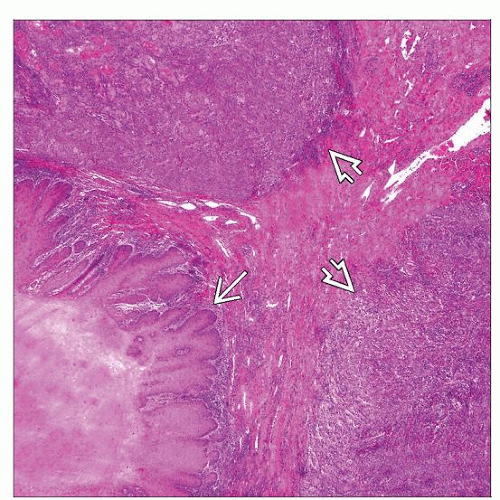Mixed Carcinoma
Antonio L. Cubilla, MD
Alcides Chaux, MD
Elsa F. Velazquez, MD
Key Facts
Terminology
20% or more of at least 1 of the histological components
Macroscopic Features
Glans is most frequently affected site
Mixed patterns of growth are common
Verruciform and superficial spreading patterns correspond to low-grade tumors
Vertical growth pattern is observed in high-grade tumors
Microscopic Pathology
Coexistence of 2 or more histological subtypes
Represents 1/3 of all penile SCC
Histological grade distribution is variegated and depends on subtypes admixed
Warty/basaloid is most frequent mixed SCC
Hybrid verrucous represents 2nd most common type of mixed SCC
Other patterns include usual-warty, usual-basaloid, and usual-papillary
Mixtures of differentiated and undifferentiated PeIN can also be identified
Focal areas of usual SCC are observed in > 1/2 of sarcomatoid carcinoma cases
Rare mixtures include adeno-basaloid SCC, mucoepidermoid SCC, and polymorphic variants
Top Differential Diagnoses
Pure SCC variants
Basaloid carcinomas
Sarcomatoid carcinomas
TERMINOLOGY
Abbreviations
Squamous cell carcinoma (SCC)
Definitions
Coexistence of 2 or more histologic subtypes
20% or more of at least 1 of the histologic components
CLINICAL ISSUES
Epidemiology
Incidence
Represents 1/3 of all penile SCC
Age
Mean age: 56 years old
Site
Glans is most frequently affected site
Foreskin location is uncommon
Treatment
Depends mainly on local extent and histologic grade of tumor
Surgical approach should be considered for tumors invading beyond lamina propria
Groin dissection should be performed based on risk group stratification
Prognosis
Related to higher grade component
Clinical behavior is variable in concordance with histologic picture and relative proportion of different components
Local and regional recurrences may occur
Inguinal nodal involvement is rarely seen
Cancer-specific mortality rate is low
MACROSCOPIC FEATURES
General Features
Gross appearance is variable
Mixed patterns of growth are common
Verruciform and superficial spreading patterns correspond to low-grade tumors
Vertical growth pattern is observed in high-grade tumors
Multicentricity is not uncommon
Average tumor size: 4.1 cm
MICROSCOPIC PATHOLOGY
Histologic Features
Most frequent patterns include mixture of human papillomavirus (HPV)-related histologic subtypes
Mixtures of usual SCC with other HPV-related and unrelated variants are also common
Histologic grade distribution is variable and depends on subtypes present
Vascular invasion, perineural invasion, and extension to distal urethra may be seen in about 1/3 of cases
Mixtures of differentiated, basaloid, &/or warty penile intraepithelial neoplasia (PeIN) may be identified in adjacent overlying mucosa
Stay updated, free articles. Join our Telegram channel

Full access? Get Clinical Tree








